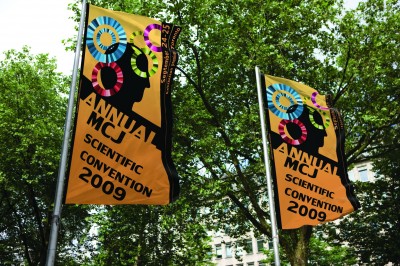
Polyester-based fabrics for banners may cost more than PVC, but the resulting soft signage can also sell for a greater price.
High-speed printing with latex inks is increasing productivity for fabric graphics, allowing large volumes of soft signage to be output in little time. This is leading to greater cost efficiencies in the textile printing industry, especially with regard to variable costs like labour.
That said, today’s market often requires low volumes of more personalized output, which are a better match for the durable aqueous inkjet printing niche than for traditional methods like gravure or screenprinting.
Ease of adoption
Fabric printing capabilities can give sign companies an advantage over their competitors, offering a new way to generate revenue with higher profit margins. While these capabilities may seem daunting at first, they have become simpler to implement. The ease of transporting and storing textiles, for example, is not just an advantage for a sign shop’s commercial clients, but also for the shop itself.
As mentioned, digital printing of fabrics is helping sign shops and printing companies target the interior design and home décor markets, as textiles already play an important role in these industries.
Print service providers (PSPs) also see textile printing catching the imagination of designers and yielding new creative applications. This is particularly true as wide-format inkjet printing technology becomes easier and more affordable to adopt, rather than limiting access to those who have invested in a device designed specifically to handle textiles. Digital inkjet printing makes short runs and even one-offs economical, allowing designers to stretch the boundaries of applications—with new image types, textures and effects—that would have been difficult and expensive with past methods.
In the future, fabric printing technologies will continue to help sign shops generate revenue from new sources, particularly by enabling the production of graphic applications that were previously not available to them, including even mainstream products like upholstery, curtains, lamp shades and garments. High-quality output will earn greater profit margins.
Greener games
One of the primary trends driving the popularity of soft signage in recent years has been a transition away from PVC and other traditional substrates in favour of textiles for environmental reasons.
In 2009, for example, the organizers of the Special Olympics World Winter Games in Boise, Idaho, led an effort to ‘green the games.’ This mission extended to the production and installation of an estimated 4,645 m2 (50,000 sf) of soft signage. These duties were handled by Fusion Imaging and Splash Events, both clients of the games’ corporate sponsor, HP.
The companies used recyclable, flexible media instead of typical PVC banner materials. Splash used a heavy textile banner material, for example, that was recyclable through HP’s free large-format media take-back program. In this way, at the end of use, unwanted graphics—including posters, banners and signs—could be returned via the print service provider (PSP) to the materials’ manufacturer for recycling.
Kevin McKay is national marketing manager for HP Canada’s graphic solutions business. For more information, visit www.hp.ca.





